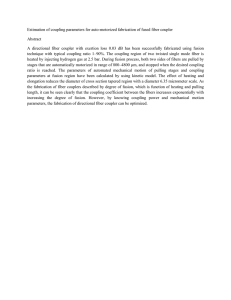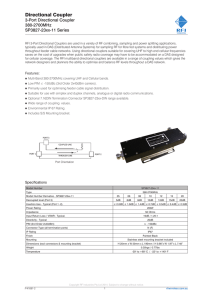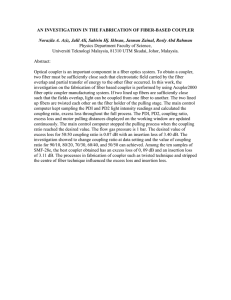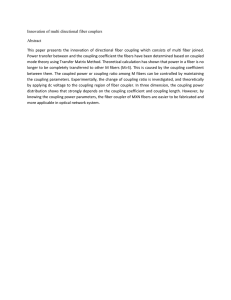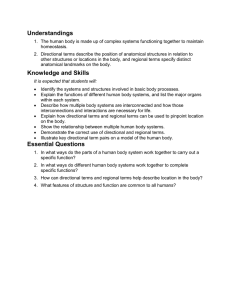High-Power Directional Couplers with Excellent
advertisement
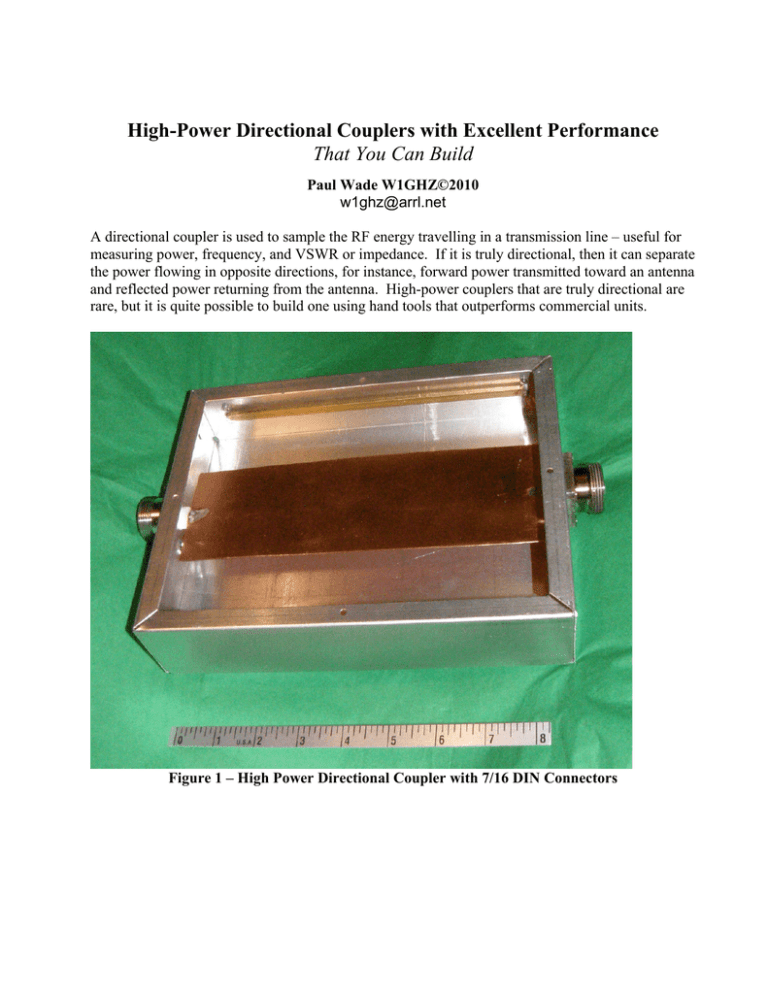
High-Power Directional Couplers with Excellent Performance That You Can Build Paul Wade W1GHZ©2010 w1ghz@arrl.net A directional coupler is used to sample the RF energy travelling in a transmission line – useful for measuring power, frequency, and VSWR or impedance. If it is truly directional, then it can separate the power flowing in opposite directions, for instance, forward power transmitted toward an antenna and reflected power returning from the antenna. High-power couplers that are truly directional are rare, but it is quite possible to build one using hand tools that outperforms commercial units. Figure 1 – High Power Directional Coupler with 7/16 DIN Connectors Directional Couplers A directional coupler, shown conceptually in Figure 2, is characterized by coupling and directivity between a main transmission line, Port 1 to Port 2, and a second transmission line, Port 3 to Port 4, coupled to the main line. The coupling is the ratio of transmitted, or forward, power, going in to Port 1 and coming out Port 2, to coupled power at Port 3, measured in dB. A coupling of -30 dB would couple one milliwatt out for each watt travelling through. Reflected power, going in to Port 2 and coming out Port 1, would be coupled to Port 4. Coupling usually varies with frequency. Figure 2 – Directional Coupler Directivity, a measure of how well the coupler separates the two directions, is the ratio of coupled power out at Port 3 to power out at Port 4 when power on the main transmission line is only flowing in one direction, into a perfect termination at Port 2. This leakage from poor directivity limits the return loss or VSWR that we can measure – for instance, a directional coupler with only 20 dB of directivity would indicate a return loss of 20 dB, or VSWR = 1.22, for a perfect load. If it were used to measure an antenna with an actual VSWR of 1.22, the unwanted coupled power due to low directivity would add to the coupled reflected power. Depending on the phases of the reflected and leakage power, the total could be twice as much as the reflected power, for an indicated VSWR of 1.5, or zero if the phases cancelled, for an indicated VSWR of 1.0, or anything in between. Higher directivity is needed to measure low VSWR. Low directivity can also affect power measurement – leakage from reflected power adds to the coupled forward power, again at unknown phase, so that measured power varies with VSWR. Commercial directional couplers, like those we find in surplus, are often designed for relatively constant coupling over a frequency range. Typically, directivity is not high over the whole range – often as low as 15 to 20 dB. Couplers found in instrumentation such as network analyzers usually have higher directivity, but are not intended for high power. The coupling in these couplers is typically -20 to -25 dB, so that measurements may be made with relatively lower power levels. Homebrew Directional Couplers I’ve been trying to make a good directional coupler for a long time. My goal is one that has high directivity, good power handling, and is robust and easily reproduced with simple hand tools. Some new projects with solid-state amplifiers gave me impetus to make this a reality. One obvious approach is a printed-circuit board – easily reproduced in any quantity. I built one years ago, and have tried other designs in software, but never with good results. A microstrip coupler, with transmission lines on top of the board and a ground plane on the bottom, has part of the energy in the dielectric and part in air, travelling at different speeds. The two parts arrive at different times, creating a phase difference, so the result is poor directivity. One alternative, a stripline coupler with ground planes on both sides, could be better, but requires multilayer PC boards, which are significantly more expensive, particularly in low-loss dielectric materials. The preferred dielectric is clearly air. One advantage for hams is that we are looking for weak coupling, so that hundreds of watts couples only milliwatts to the coupled port. This makes the design considerably easier. Textbooks1 on coupler design describe odd-mode and even-mode impedances where the two lines are coupled, and the necessary impedances and spacing for the desired coupling ratio. For weak coupling, less than -30 dB, the numbers reduce to two lines with impedance very close to 50 ohms, spaced relatively far apart. For high powers, we want wide lines, to carry high currents, with large air gaps, for high voltages. However, the high power is only on the main line – the coupled line only sees low power, and is spaced a good distance away, so it can be much smaller. One of my directional couplers is shown in Figure 3. A diecast aluminum box provides a robust enclosure that will not flex, so spacings are consistent and performance is constant. A wide, flat stripline centered between top and bottom makes a nice main transmission line. The width is great enough that a small error has little effect, and any slight offset up or down from the center is inconsequential. The smaller coupled line is along one edge of the box, using the wall as a ground plane. The main line has type-N connectors, while SMA connectors are adequate for the coupled ports. Figure 3 – Homebrew Directional Coupler (Larger version) To achieve accurate 50-ohm lines and an estimate of coupling, I simulated the coupler using Ansoft HFSS software2. This 3D electromagnetic simulator is much more accurate than simple programs like AppCAD3 and graphs in books, particularly for odd shapes that I tried. For the coupled line, I started with a simple round rod over ground but found the spacing above ground to be much less than AppCAD calculated (probably because the equation is not accurate for low impedances). A flat strip would be good, but not rigid enough to maintain constant spacing and impedance. Rectangular hobby brass tubing (or WR-22 waveguide, for the extravagant) makes a rigid line and makes the space large enough to allow for reasonable tolerance. These simple shapes, wide stripline for the main line and microstrip (with air dielectric and a very thick line) for the coupled line, calculate to between 50 and 51 ohms in both HFSS and AppCAD. The frequency range is set by the length of the coupling line – maximum coupling should occur when this length is an electrical quarter-wave. Above and below this center frequency, the coupling decreases, but directivity typically does not decrease at lower frequencies; sometimes it improves. Knowing this also allows us to use surplus directional couplers at frequencies well below the rated frequency. The maximum coupling is set by the separation between the two lines, and falls off predictably at lower frequencies. Thus, we can achieve a desired coupling at a particular frequency by adjusting the spacing or the coupled length, or both. Results I built two couplers with Type-N connectors using this basic design – a large one for 1296 MHz down to VHF, Figure 3, and a smaller one to get up to 2400 MHz, shown in Figure 4. Maximum frequency is limited by resonances in the boxes at roughly 1.7 GHz for the larger box and 3.0 GHz for the smaller. Higher frequencies would require smaller boxes and better transitions from coax to stripline. Figure 4 – Homebrew Directional Coupler (Smaller version) Measured S-parameters are shown in Figure 5 for the larger directional coupler, and in Figure 6 for the smaller one. For those who aren’t fluent in S-parameters, relevant quantities are shown individually: Coupling in Figure 7, Directivity in Figure 8, Loss in Figure 9, Return Loss in Figure 10, and VSWR in Figure 11. Finally, numerical values for amateur bands are listed in Table 1. Copies will not have these exact values – calibration at the desired frequency is required for exact results. Figure 5 – Measured S-parameters for Larger Directional Coupler The larger coupler has excellent directivity up to 432 MHz, and is still good at 1296 MHz. The smaller one has excellent directivity up to 1296 MHz, and is still good at 2400 MHz. Measured directivity in Figure 7 appears noisy because the reflected power is more than 90 dB down, near the noise floor of the VNA. At the VHF frequencies, the smaller version has very weak coupling, so the larger one would be preferable. Figure 6 – Measured S-parameters for Smaller Directional Coupler The wide lines have very low loss and should be adequate for high powers. I was only able to test them at 500+ watts at 144 MHz and 100 watts at 903 MHz, but they work fine at these power levels. Figure 7a – Coupling for Large Directional Coupler Figure 7b – Coupling for Small Directional Coupler Figure 8a – Large Directional Coupler Directivity Figure 8b – Small Directional Coupler Directivity Figure 9a - Large Directional Coupler Insertion Loss Figure 9b – Small Directional Coupler Insertion Loss Figure 10a - Large Directional Coupler Return Loss Figure 10b – Small Directional Coupler Return Loss Figure 11a - Large Directional Coupler VSWR Figure 11b – Small Directional Coupler VSWR A Higher Power Directional Coupler The two directional couplers described above recently appeared in DUBUS4. When I saw them described as QRO, I knew some of the EME community would take issue – some of them run enough power that type N connectors are inadequate. The popular coax connectors for real QRO seem to be the 7/16 DIN connectors, so I decided to make another directional coupler using these connectors, shown in Figure 1 above. The 7/16 DIN connectors are relatively expensive, but I located a few connectors at a reasonable price on the internet and bought them. The mounting flange is larger than a type-N connector, so a larger enclosure is required. This suggested a lower frequency design, so I chose to aim for -40 dB coupling and a center frequency of 432 MHz. A stock aluminum chassis, 7x9x2 inches, seemed just about right, and I had one on hand. The construction is very similar to the other couplers – a wide copper stripline for the main line, and an air microstrip on the side wall for the coupled line. I chose to leave the full length of Teflon insulator on the connectors to maximize power capability, at the cost of a small discontinuity that increases VSWR slightly at 432 MHz. Minimum spacing is about 6.5 mm for the main line, so it should handle any power level that amateurs can generate. Figure 12 – S-parameters for Higher Power Directional Coupler Performance is excellent, and very close to the goal – coupling is -40.7 dB at 432 MHz, increasing to -46.6 dB at 144 Mhz and -55.3 dB at 50 MHz. Directivity is better than 30 dB through 432 MHz. The measured S-parameters are shown in Figure 12, and separated into individual graphs in Figures 13 through17. If higher coupling is desired, increase the separation between the main line and coupled line. Simulations show an increase of 0.5 dB for each additional millimeter of spacing – an additional 20 mm of spacing will yield a -50 dB coupler, and a further 20 mm results in -60 dB coupling. Figure 13 – Coupling for Directional Coupler with 7/16 DIN Connectors Figure 14 – 7/16 DIN Coupler Directivity Figure 16 – 7/16 DIN Coupler Return Loss Figure 15 – 7/16 DIN Coupler Loss Figure 17 – 7/16 DIN Coupler VSWR Directional Coupler Performance at Amateur Bands W1GHZ 2010 Band 50 144 222 432 902 1296 Large Coupling Directivity Insertion Loss Return Loss VSWR Power per mw Coupled @ 1 KW -51.3 34.9 0.03 45.7 1.01 136 7.37 -42.3 32.3 0.04 38.9 1.02 17.0 58.7 -38.7 29.7 0.04 37.1 1.03 7.4 135.5 -33.6 27.0 0.06 39.4 1.02 2.3 441.4 -30.3 23.6 0.10 27.2 1.09 1.1 933.9 -32.9 22.5 0.15 23.0 1.15 2.0 511.7 Small Coupling Directivity Insertion Loss Return Loss VSWR Power per mw Coupled @ 1 KW -71.3 19.7 0.03 44.0 1.01 13423 0.07 -62.7 29.4 0.04 36.7 1.03 1847 0.54 -58.6 43.2 0.05 33.9 1.04 722 1.39 -53.1 31.7 0.06 31.3 1.06 206 4.86 -46.8 31.5 0.13 29.6 1.07 47.7 21.0 -43.8 32.1 0.10 30.3 1.06 24.2 41.4 7/16 DIN Coupling Directivity Insertion Loss Return Loss VSWR Power per mw Coupled @ 1 KW -55.3 33.0 0.04 36.6 1.03 338 2.96 -46.6 33.3 0.06 31.6 1.05 45 22.1 -43.4 34.8 0.07 34.2 1.04 22 45.5 -40.7 30.6 0.11 23.3 1.15 12 84.5 -50.9 21.2 0.16 28.3 1.08 124 8.1 -39.0 15.3 0.45 16.3 1.36 8 126.5 Table 1 2304 2400 MHz dB dB dB dB Watts/mW mW -39.6 22.2 0.17 21.2 1.19 9.1 109.7 -39.4 21.4 0.18 20.9 1.20 8.6 115.9 dB dB dB dB Watts/mW mW dB dB dB dB Watts/mW mW Construction A sketch with important dimensions indicated is shown in Figure 18, and a cross-sectional view in Figure 19, and a summary of dimensions I used in Table 2. More important than the exact dimensions I used are the factors needed to realize a different coupling ratio, to utilize metric materials, or to make a higher power version using 7/16 DIN connectors, so that a coupler can be customized for individual requirements. Figure 18 – Homebrew Coupler Dimensions, Top View Figure 19 – Homebrew Coupler, Cross-section View Design Large inches Hammond 1590BB Enclosure Coupled Length Height Main Line Width Taper Separation Coupled Line " above wall Small mm ≈ 1/4 λ or less enclosure 1.35 * Height best VSWR for coupling 50 ohms 50 ohms inches 7/16 DIN mm inches mm Hammond 1590-B Bud AC-406 3.4 1.18 86.4 30.0 1.36 1.05 34.5 26.7 7.5 2.0 190.5 50 1.59 0.1 1.75 40.4 2.54 44.5 1.42 0.16 2.0 0.25 x 0.125 0.065 36.1 4.1 50.8 2.7 0 0 68 0 0 0.25 x 0.125 0.065 1.65 1.65 0.25 x 0.125 0.065 1.65 Table 2: Directional Coupler Dimensions The line dimensions for 50 ohms are most important – the main line, 0.020 inches (0.5mm) thick, has a width of 1.35 times the inside height of the box. The coupled line impedance is set by spacing above ground. For the coupled line, I used rectangular hobby brass, 0.250 x 0.125 inches. For this aspect ratio, the spacing above ground is about 0.27 times the width of the coupled line. Taper at the end of the main line affects VSWR and directivity – 100 mils (2.5mm) for the large version and 160 mils (4.5mm) for the small one seemed to give good results. I also rounded off sharp corners of all the lines with a file. The main line connectors may be moved side-to-side to adjust coupling, and need not be centered in the box. In the smaller coupler, I put them slightly off-center to increase the coupling slightly. Calculated curves of coupling vs frequency are shown for several different separation distances, measured from the end wall (under the coupled line) to the main line connectors, are shown in Figure 20 for the large coupler and Figure 21 for the small coupler. Measurements of coupling on my units are within one dB of the calculated values. The center frequency, where maximum coupling occurs, is slightly higher in Figures 20 and 21 than expected from quarter-wavelength calculation, and the center frequency increases with weaker coupling. By scaling these curves, it should be possible to estimate the dimensions for a desired coupling at any frequency. Figure 20 – Calculated Coupling vs Separation and Frequency for Large Coupler Directivity and VSWR vary a few dB calculated values, since small variations in construction affect these values. Generally, looser coupling tends to have higher directivity, and careful construction improves both VSWR and directivity. Figure 21 – Calculated Coupling vs Separation and Frequency for Large Coupler Construction is simply marking and drilling holes, and tapping the threads for the screws. The main line is cut to size, fit in place, and soldered. The coupled line has two holes drilled at the same distance as the connectors, then slid over the connector pins. To control the spacing above ground, I use a pad of Post-It notes. Remove sheets until the pad is the desired thickness (0.065 to 0.070 inches, or 1.65 to 1.77 mm) as measured with a caliper or micrometer, slide the pad under the line as shown in Figure 22, push down, and solder the connector pins. Remove the pad, file the pins flush, and clean up. For the longer lines of the coupler with 7/16 DIN connectors, I used a pad at each end to make the spacing uniform. Figure 22 – Setting spacing above ground for Coupled line Uses for Directional Coupler Power Measurement – a directional coupler, accurately calibrated, can be used to measure high powers accurately. A chart like Table 1 listing Watts per milliwatt of coupled power at each frequency assists in quick, accurate calculation. Test sessions at many VHF and up meets make a Vector Network Analyzer available for quick calibration; otherwise, comparison to a known power meter may be used. VSWR and impedance – measurement of both forward and reflected power yields Return Loss, which is easily converted to VSWR if preferred. Complex impedance requires a network analyzer connected to the two ports, either a surplus unit or homebrew like my Handheld Network Analyzer4. Sampling – a tiny bit of the signal is available to measure frequency, or spectrum, or to use for ALC or other feedback. Spectrum measurements will require correction for the variation in coupling with frequency. Amplifier protection – many solid-state amplifiers are less tolerant of high VSWR than are large triode tubes. Sensing both forward and reflected power with a directional coupler can monitor Return Loss continually, and it can be used to automatically shut down when VSWR is excessive. One simple way to do this would be to put an attenuator on the forward port with value equal to the desired maximum return loss. Then a simple comparator IC can sense when reflected power is greater than attenuated forward power and operate a relay or solid-state switch. For instance, a 10 dB attenuator at the forward port would make the forward and reflected outputs equal for a Return Loss of 10 dB, or a VSWR of 1.92. Note that any power reflected from the forward port travels along the coupled line and appears at the reflected port as erroneous reflected power, just like poor directivity. So, if the power detector does not have good VSWR, an attenuator will improve matching and allow more accurate measurements. Accuracy in power measurement also depends on the accuracy of the power meter used to measure coupled power. Surplus power meters like the HP-432 are fairly common, and can be easily calibrated. A simple IC power detector5 is probably less accurate, but can be adequate for many uses, such as amplifier protection or remote monitoring of power. The amateur standard for high-power measurements has been the Bird 43 wattmeter. At VHF and UHF frequencies, these are quite accurate when new and have good directivity, but they are rather expensive to leave in the line for constant monitoring. Used units of questionable provenance also have questionable accuracy and are hard to repair. Summary These easy-to-build directional couplers demonstrate that it is possible to homebrew a quality coupler suitable for high power measurements. Curves are included which should make it possible to tailor one to any desired frequency and power level. References 1. G. Matthaei, L. Young, and E.M.T. Jones, Microwave Filters, Impedance-Matching Networks, and Coupling Structures, McGraw-Hill, 1964. 2. www.ansoft.com 3. http://www.hp.woodshot.com/ 4. Paul Wade, W1GHZ, “High-Power Directional Couplers with Excellent Performance – That You Can Build,” DUBUS, 2/2010, pp.10-23. 5. Paul Wade, W1GHZ, “Antenna Ratiometry Measurements for the 21st Century Using a Homebrew Ratiometer (also a Handheld Network Analyzer),” Proceedings of Microwave Update 2005, ARRL, 2005, pp. 40-63. also available at http://www.w1ghz.org/small_proj/hna.zip 6. Paul Wade, W1GHZ, “Microwave Integrated Power Detectors,” DUBUS, 4/2008, pp. 5873.
